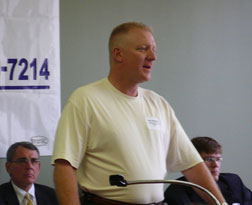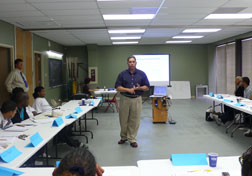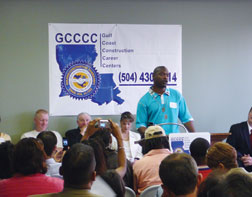 |
Hoping to boost its visability in an open shop stronghold and bolster numbers and skill levels of a badly needed craft workforce, the AFL-CIO’s Building and Construction Trades Dept. is bringing its message to the Hurricane Katrina recovery zone through a fast-track training and job placement center that will feed recruits to union apprentice programs for the first time.
The Gulf Coast Construction Careers Center in New Orleans is a joint venture between the building trades and the Louisiana Works Workforce Commission, a state-funded workforce development program. “Our goal is to deliver 225 people per year, 675 in a three-year time period,” says Art Lujan, the center’s executive director. “We want to achieve the highest possible number because the industry needs them.” The AFL-CIO is using the program to test innovative strategies and develop a template for fast-track training in other low-density union markets, he adds.
 Angelle Bergeron/ENR Major reconstruction projects in New Orleans such as the 17th Street Canal need more skilled craft workers.
|
When AFL-CIO President John Sweeney visited New Orleans in June 2006 to announce a $1-billion labor-sponsored Gulf Coast revitalization program, he promised to include a workforce development pilot project to help the struggling area meet anticipated reconstruction labor demand. In August, the center will graduate its third class of pre-apprentices, introducing the first trickle of new recruits. Lujan says a $3-million state block grant that will fund the center “just got finalized.” Eager to jumpstart training, the AFL-CIO’s Housing Investment Trust is adding $1 million. “The problem is there is money on the street, but no one knows how to utilize it for training. We are used to training,” says Lujan.
|
"We are trying to entrench ourselves in the community. It will take a whole village to develop a workforce." — Art Lujan, Training Center Director
|
The first of the three-week-long, all-day preapprentice training sessions are being held in a local ironworkers’ hiring hall, with plans for a permanent facility later this summer. The program is designed to stimulate reconstruction of homes and the city’s devastated middle class through job skill training and union-funded projects to put people to work.
But union executives admit that project funding is also bogged down. The AFL-CIO committed $750 million to local reconstruction in the New Orleans area, but to date, no specific projects have been earmarked. “Things have not gone as fast as we had hoped two years ago,” says Tom O’Malley, director of the housing fund’s community investment initiatives.
 Angelle Bergeron/ENR Sean McGarvey, secretary-treasurers of the AFL-CIO’s Building and Construction Trades Dept., welcomed program graduates in June to union construction.
|
He and other top union officials were on hand at the June 22 graduation of the program’s first class to encourage students and publicly tout the AFL-CIO’s presence. “On behalf of the people I represent, three million strong, welcome to the family,” said Sean McGarvey, building trades’ department secretary-treasurer.
With many remaining obstacles in post-Katrina New Orleans, that family will likely have to pool its vast resources to ensure that the preapprentice program is a success. The first class of 22 was followed by one of 16 and only a dozen are set to graduate in August.
One problem is the program’s grant-required pre-admission testing, which is performed by a local technical college. “That’s been a chokepoint, the fact that we can’t get enough people tested in order to generate a full class,” says Lujan. “Only 25% of those taking the exams are passing, so we have to do some additional remediation.” He is already working with the American Federation of Teachers and the Urban League, among other groups. “We are trying to entrench ourselves in the community and partner with other organizations who are doing good stuff,” Lujan says. “It will take a whole village to develop a workforce.”
Center officials also cite the recovery zone’s other issues. “We know the pool of recruits will be smaller than what we need here because of the lack of adequate, affordable housing and public transportation,” Lujan says. “If you don’t have reliable transportation that will carry you into surrounding parishes or across [Lake Pontchartrain], your chances for success are going to be very limited because there is not that much work going on in New Orleans. That’s what makes everything so complicated here.”
 Angelle Bergeron/ENR Marty Branighan Jr. director of the New Orleans Electrical Joint Apprenticeship and Training Committee, gives students facts about being an apprentice, including wage rates and advancement opportunities
|
The state grant requires that at least 51% of each class of students live in New Orleans, and had to have been affected by the storm. Classes include intensive training in life skills, remedial math and introduction to various craft apprentice programs. Upon completion of preapprentice training, attendees will be paid a stipend of $10 per hour for 120 hours.
Students are recruited to the program through various channels, including state efforts, technical schools, corrections programs, local sherriffs and faith-based organizations. “I talked to a lot of mothers and sat in a lot of living rooms,” says Maria Alexander, worker services coordinator. Born and reared in New Orleans, Alexander spent the last 20 years in New York City working for non-profits and community building programs. “I decided to come home after Katrina,” she says. “I had given New York 20 years, and it was time to come home and help people I know. We had bigger problems here.” Alexander, whose father was in the plasterers' union, views the program as not just workforce training but a stepping stone to rebuild lives. “This is not only to help them get a job or build a house, but to change their attitude about work,” she says.
Alexander is pushing hard to bring more women into the program, fighting the prevailing “Southern belle” perception, she says, adding that the center is working with a University of New Orleans’ women’s group, a professional women’s football team and others. She is also recruiting in the city’s hurricane-hit Vietnamese and Hispanic enclaves.
 Angelle Bergeron/ENR Byron Jackson, who lost much during Hurricane Katrina, hopes to make a new start as an electrician’s apprentice.
|
Byron Jackson was in the first graduating class and is currently working as an electrician's apprentice for local contractor Walter D. Barnes Electric. After evacuating to Georgia, losing all his possessions to floodwaters and having his family scattered across the country, he suffered the death of both his wife and son. “I guess I was like Dorothy from the Wizard of Oz. There's no place like home,” Jackson says about his decision to return to the city. “I looked at this as a chance for me to get started again,” Jackson says of the preapprentice training program. “Art [Lujan] said something the very first day that captivated me; he said, ‘We're not preparing you for a job. We're preparing you for a career.' ”
Lujan touts the union training model and potential. “We have the ability to break cycles of poverty and exploitation and rebuild the middle class here and throughout the rest of the country,” he says. The fast-track training becomes a paid introduction...


Post a comment to this article
Report Abusive Comment